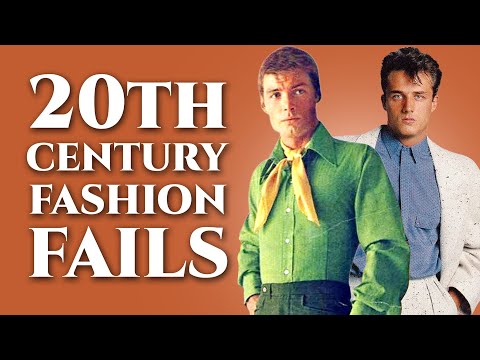The WORST Men's Fashion Fails of the 20th Century!

Welcome back to the Gentleman's Gazette. In today's video, we'll discuss the weirdest, wildest, and most outright painful men's fashions of the 20th century. ♪ The Gentleman's Gazette theme song ♪ If you cast a critical eye back through time, you can see that there's much evolution and change that has occurred with menswear over the centuries. All of these changes have meant that we can deal with modern luxuries and conveniences and styles of clothing that we think are appropriate.
But, frankly, there's also just been a lot of downright silliness. Indeed, the 20th century had many fairly ridiculous fashions over the course of its 100 years. And while we can't cover all of them, we've hand-picked a few from each decade that we think are particularly egregious.
Now, it should be said that not all of these fashion trends were commonplace. Certainly, it wasn't the case that a majority of men were wearing all of them and indeed, some were even fairly unpopular at the time. But, with that said let's just go in for the giggles today and look at some of these silly fashion choices. We'll go in chronological order today, starting of course with the 1900s and 1910s - an economic boom time, a time of mechanization, and a time of ridiculously tall shirt collars.
As menswear historians, we have to admit that the look of a stiff detachable collar can be quite sharp in some circumstances. But with that said, the collars of the 1900s could be quite tall - sometimes even reaching a whopping three and a half inches in height. Legend has it that if men fell asleep in these tall collars with their heads bent forward, they could even cut off circulation and oxygen to the brain. Some men were said to have died from asphyxiation, giving these collars the cheerful nickname of "vatermorder" or "father killer." And while obviously not as severe as death, other men experienced inconveniences like friction sores or rashes and so, some took to using a special wax called glattolin. With all that said, though, we don't want to put you off of detachable collars entirely.
When worn at the right height that corresponds well with your neck, they can be comfortable - at least, once you get used to them - and indeed, they can be quite stylish. Let's now turn our attention to the 1920s and 30s with our first item here being Oxford bags. Today, of course, classic menswear enthusiasts fight against the modern trends of ultra skinny trousers by wearing pants that have a leg width that's more in the middle and flattering to multiple body types. But, if you want to go to
the complete opposite end of the spectrum from the tight-fitting trousers of today, look no further than the Oxford bags of the 1920s. These were incredibly wide-legged trousers that had their origins at Oxford University around about 1924. For reference here, the leg width of modern trousers tends to sit around an average of 18 inches, and, indeed, these Oxford bags started out not too much wider than average at a width of about 22 inches. But, at their widest, they reached a ridiculous
44 inches in width. If nothing else, they might come in handy for a particularly comfortable three-legged race at a county fair or, alternatively, if you fell from a plane wearing oxford bags, you wouldn't even have to be wearing a parachute to land safely. Now, not everyone was wearing this style of trousers even at the time, but they persisted in one form or another for almost 30 years and even reached a revival of sorts in the 1970s. Let's now move into the 30s and 40s, which we consider to be the center of the so-called Golden Age of menswear. Indeed, we don't really have too much to discuss
in this period as many of the fashions were fairly middle of the road. We might even go so far as to say boring. Then, again, this is our preferred era of menswear and you'll hear us talking up his virtues all the time. So, it's perhaps not surprising that we don't have too many nitpicks or gripes here. So, if we were to call suits from this era boring, we'd focus mostly on the early to mid-1940s as World War II was getting into swing and fabric rationing stopped fashion from evolving. After all, it was seen as patriotic at this time to save fabric for the front lines. So, not many suits featured excessive fabric and therefore, had narrower trouser legs than in years prior and they also didn't feature decorative buttons or trims, patch pockets, or even cuffed pants. As these all used more material than was necessary. And also, because of fabric rationing,
double-breasted jackets became less popular around this time. Although, they did experience a resurgence once rationing requirements eased off. In some countries, such as Britain, there were certain restrictions that were put in place on details that garments had. For example, things like cuffs or turn ups were banned and double-breasted jackets were disallowed. If we were to single out a fashion fail from this era, it would probably be in the realm of men's workwear, specifically matching work sets that were worn by servicemen, delivery drivers, and the like, and that were styled to military uniforms to further give the sense that everyone was doing their part. These would usually
consist of shirt, pants, and short jackets all made from matching colors and fabrics, usually in mercerized or sanforized cotton or in a rayon cotton blend. By the way, mercerized fabric has been treated with sodium hydroxide and sanforized fabric has been pre-shrunk before it's made into a garment. The idea behind these processes was to make the garments more long-lasting and hard-wearing, perfect for work uniforms. They were also advertised as being tub fast, which meant they could be washed at home with then contemporary laundering methods and thus, didn't have to be dry cleaned. The shirts often featured camp-style collars, which were popular at the time, and they could be buttoned all the way up to be worn with a tie or bow tie or left unbuttoned to give the appearance of a small pseudo-lapel. They also often featured a breast pocket on both sides
for holding work tools. The trousers were high-waisted and could come in flat-fronted or pleated varieties and were often worn with belts that again came in fabric of the same color, though some men opted to wear regular leather belts instead. The matching jacket was also, of course, in the same fabric and emulated the shirt, often also having pockets on both sides of the chest and stopping right around the waistband. The difference here being that the jacket was fastened with a zipper and was often thicker than the shirt. Because the colors often merged together and gave an overall stale and dull appearance, these really weren't fashionably-inspired ensembles, but then again, they were work uniforms so the men wearing them didn't have much of a choice, and after all, they did have more important things to worry about at that time. Let's turn now to the 1950s, where especially in Britain we saw the advent of the "Teddy Boy." The Teddies or Teds
were a subculture of young British men who wore pseudo-Edwardian or Edwardian-inspired ensembles. This came about in the post-war era when several row tailors attempted to re-insert things like long jackets and fancy waistcoats to servicemen who had returned from the war. However, these looks didn't really go over well. So, the tailors had to cut their losses and sell them cheaply to the general public. They were mostly picked up by young working-class men and were originally
associated with delinquents called "cosh boys," but by 1952, the style was spreading throughout the UK and was associated with the emerging rock and roll subculture. The style was given the name "Teddy Boy" in 1953 when a reporter for the Daily Express newspaper shortened Edwardian to Teddy. As you can see, the style featured things like long jackets with velvet trims, sometimes in bright colors and with fantastically fancy waistcoats, as well as Western-style bow ties or bolo ties, and even creepers as footwear. Of course, all of this is hardly anything like genuine styles of the Edwardian period, but these clothes certainly did turn heads. Although, perhaps the most eye-catching aspect of the overall aesthetic was the hairstyles. These styles were reminiscent of bird beaks, croissants, and even tongues drooping down from the heads of the wearers. Of course, you
needed a lot of hair and a lot of product to pull these styles off and hairstyles got bigger and bigger over time. The Teddy Boy style even had a brief comeback in the 1970s and, indeed, there are probably still a few Englishmen rocking the style today. Alright. Now, as we get into the latter half of the 20th century, we can feel the classic menswear enthusiasts out there cringing right along with us because, of course, the 60s, 70s, and 80s are all known for their particularly terrible fashion choices. But, bear with us as we soldier on here and get into the 1960s with the body shirt. These shirts, which were cut similarly to body coats, with seams that made the shirt fit as close to the body as possible might seem bad enough. But, once you combine them further with
wildly patterned trousers, velvet suits, a mix and match of over-the-top bright colors, huge bow ties, an obsession with colorful tartan, and ruffled shirts, you've got yourself a pretty eccentric and overall, a pretty ugly era. And, of course, we can't talk about the 1960s without mentioning hippies, a subculture of the time that were decried by many as a bunch of lazy, do-nothing, beatnik young kids. Traditional norms were out the window and, indeed, that didn't stop at their clothing choices or perhaps, lack thereof. either. Of course, the hippie movement has its defenders even today.
But, we can probably agree that with their colorful, crazy, psychedelic, and mismatched ensembles, you can see where some of the other fashion fails of the 1960s came from. We're not going to hit the entire decade with the fashion fail stamp of silliness as there were still more traditional ensembles worn by some men. But, once we get into the 1970s, all bets are off. We'll start here with the so-called "dog-ear shirt." Now, today, men's collar leaves on dress shirts are getting smaller and smaller, leaving the traditionally-minded among menswear enthusiasts hoping that collar leaves will start to get longer again. But, we should be careful not to go too far in the opposite direction or we might end up with these dog-ear collars. These shirts featured collars with ridiculously
long and rounded leaves, leading some to even call them "man boob collars" or "saggy boob collars." We apologize in advance. It's no secret that, at the Gentleman's Gazette, we're interested in helping men to find clothing that fits them well and complements their frame. So, with that in mind, we ask, "Why would anyone wear a jacket with lapels so wide you could land an airplane on them?" 1970s lapels were ridiculously wide and colorful. It was a look that didn't look good on many men. But, indeed, a trend is a trend so most followed suit. If you'll pardon the pun.
[Cricket noises] Of course, lapel widths have fluctuated over time, seeing periods of wideness in the 1870s and again, in the 1940s. But, by the time we see the wide lapels of the 70s, one major gust of wind and you might as well fly away. Moving on to our next item, we move down under to Australia. Indeed, summers there can get quite hot. So, naturally, men are always looking for ways to cool down. But, if you ask us we'd probably rather boil to death in wool trousers in the summer than be caught wearing Stubbies. These were a style of shorts or, indeed, short shorts that were invented as casual wear, but also became a staple of workwear for a time.
Frankly, they're pretty unflattering, and to add insult to injury, they were also often worn still with high socks. And as our final item from the 70s, we'll be taking a look at bodysu... [Preston retching] Body...
Nope! I can't do it. I can't do it. Let's move on. Now, the1980s weren't so innocent either with their focus on huge hair, the mullet, and whatever these styles are. But, as we alluded to previously, the worst crime of this era has to be the 1980s power suit. Overall, 80s suits were guilty of overlypadded shoulders, wide-cut bodies and unflatteringly-low button stances that threw off the proportions of the suit informed originally by the golden ratio. And, although the trousers were usually higher-waisted than modern trousers today, the extremely low buttoning point of the squared-off jackets made the torso look larger, the legs look smaller, and indeed, the head of the wearer looked tinier as well. Also because of the low button stance,
double-breasted jackets tended to cross much lower on the body and could sometimes gape and gap at the top, again leading to an unflattering square silhouette. These double-breasted suits would make their counterparts from the 20s and 40s fall apart in disappointment. But, then again, the shoulder pads could suit Frankenstein's monster. So, if you look anything like Boris Karloff after 4 hours of movie makeup, then they might be a good choice for you. Now, to the final decade of today's video: the 1990s.
[Scene from the music video of As Long As You Love Me by The Backstreet Boys plays] While the fashion crimes here aren't as severe as some of the previous decades, they are still numerous. If we had to pick one area though, we'd say that the worst fashion crime of the 90s had to be the decade's obsession with denim. Denim trousers also called "jeans" were invented in 1873 by Levi Strauss and Jacob Davis as workwear. And indeed, you can learn more in our history section of the "Is It Worth It" video we've done on Levi's here. Over the course
of the 20th century, denim worked its way into casual wear ensembles. But, by the 1990s, things had definitely gone overboard. As one example, we can turn to the oversized, low-hanging baggy jeans made by companies like JNCO, which were originally made for young boys but came to be worn by adults as well. And we could also bring up this photo from 2001 featuring Justin Timberlake in jeans and a matching denim jacket as well as a denim hat while Britney Spears is wearing a denim dress with a matching denim bag. Despite what they may have heard at the time, a Canadian tuxedo really shouldn't be worn on the red carpet or elsewhere. Luckily for us, this trend would eventually die
out and "double denim" became a phrase associated with poor fashion taste. And by the 90s, we were starting to see the beginnings of what we're still experiencing today, where traditional casual menswear is being supplanted overall by streetwear and other casual fashions. Now, we're not going to decry this entirely as there certainly is a place for more casual dressing. Indeed, you can even work things like jeans into more classically-inspired menswear ensembles.
Just make sure that they're dark wash, free of too much detailing or distressing, and work well with your body type. In conclusion then, with all these weird and wild fashion trends over the course of the 20th century, it should be no secret why we at the Gentleman's Gazette prioritize a wardrobe that is not only classic, but also timeless. In other words, if you make an effort to follow the fundamental principles of aesthetics that we outline in several other videos, you can be confident that you won't have to look back at photos from a certain period and cringe. If there's a lesson to be learned from today's video other than, of course, not wearing any of the styles that we've directly profiled here, it should be that following trends is a surefire way to have future generations laugh at you. I've tried to get into the spirit of things a bit in today's video by wearing a suit from my own wardrobe that does have some frankly 80s-inspired power shoulders to it that are perhaps just a bit wide for my build. The overall fit of the suit though
does complement my frame fairly well and isn't overly boxy. And I like the dark brown color and faint stripe in light blue and tan, which is more classically-inspired. I've paired the suit with a simple, light blue dress shirt that has French cuffs into which I've inserted our gold-plated sterling silver eagle claw cufflinks with tiger's eye as the stone that harmonize with the brown of the suit. These cufflinks are from Fort Belvedere as are my other accessories today, including my grenadine tie, which is in a cashmere wool silk blend and features orange and gray tones, as well as a thin white stripe, our orange exotic Caribbean boutonniere, and the pocket square in silk, which features a large paisley pattern of orange, blue, green, red, and white. Also from Fort Belvedere are my two-toned, shadow-striped socks in navy blue and royal blue to harmonize with the shirt, but also to pick up on the striped motif of the suit. Rounding out the outfit today are a simple pair of dark brown Oxfords from Allen Edmonds and, of course, you can find all of the Fort Belvedere accessories I'm wearing in today's video in the Fort Belvedere shop here.
♪ The Gentleman's Gazette theme song ♪
2021-07-07 12:54


